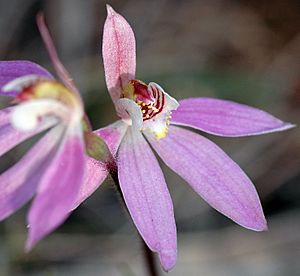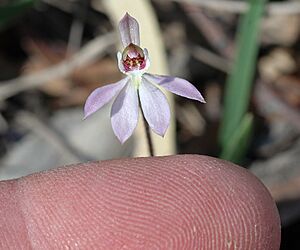Pink fingers facts for kids
Quick facts for kids Pink fingers orchid |
|
|---|---|
 |
|
| Caladenia carnea in the southern midlands of Tasmania | |
| Scientific classification | |
| Genus: |
Caladenia
|
| Species: |
carnea
|
| Synonyms | |
The Pink Fingers Orchid, also known by its scientific name Caladenia carnea, is a beautiful plant that belongs to the orchid family. You can find it growing only in eastern and south-eastern Australia, including the island of Tasmania. This special orchid has a single thin, green leaf. It produces one to five flowers that are usually white or pink. These flowers often have cool red stripes and tiny yellow-tipped bumps called "calli" on their special lower petal, known as the labellum.
Contents
About the Pink Fingers Orchid
The Pink Fingers Orchid is a plant that grows from the ground. It is a perennial plant, which means it lives for more than two years. It's also a deciduous plant, meaning it sheds its leaves at certain times. This orchid is a herb with a special underground part called a tuber. It has one long, thin leaf, about 90 to 150 mm (3.5 to 5.9 in) long and 3 to 4 mm (0.12 to 0.16 in) wide. This leaf has a few tiny hairs on it.
Flower Details
The flowers grow on a stem that can be 120 to 250 mm (4.7 to 9.8 in) tall. Each stem can have one to three, or sometimes even five, flowers. These flowers might smell sweet or a bit musky.
The top petal, called the dorsal sepal, usually stands straight up. It's about 10 to 15 mm (0.39 to 0.59 in) long. The side petals and other sepals are about 8 to 15 mm (0.31 to 0.59 in) long. The outside of these petals is covered with tiny glandular hairs. Their outer color is usually greenish-pink, sometimes with stripes. The inside is pinkish or greenish-white.
The most interesting part is the labellum, which is a special lower petal. It's shaped like an egg, about 5 to 8 mm (0.20 to 0.31 in) long and wide. It's white or pink with clear red stripes. The sides of the labellum curve upwards. The middle part has a jagged edge, usually with yellow "calli" (small bumps). There are also two lines of raised, club-like calli with yellow tips in the center.
The central part of the flower, called the column, is curved. It has red bars on the inside and narrow "wings" on its sides.
Life Cycle and Reproduction
Pink Fingers Orchids usually bloom between August and November. After the flowers, a dry seed pod, called a capsule, forms. This capsule opens up to release many tiny seeds.
Similar Orchids
Sometimes, people might confuse this orchid with another one called Caladenia fuscata. However, Caladenia fuscata always has only one flower per plant and blooms a few weeks earlier than the Pink Fingers Orchid.
How Pink Fingers Orchid Got Its Name
The scientific name Caladenia carnea was first officially described by a botanist named Robert Brown in 1810. He wrote about it in a book called Prodromus Florae Novae Hollandiae. Later, in 2001, two other scientists, David Jones and Mark Clements, suggested changing its name to Petalochilus carneus. But this new name hasn't been widely used.
Where Pink Fingers Orchid Lives
You can find the Pink Fingers Orchid in many parts of eastern and south-eastern Australia. This includes:
- Queensland, south from Hervey Bay
- The eastern half of New South Wales
- Most of Victoria, except for the alps and far north-west
- South-eastern South Australia
- Tasmania
This orchid is quite adaptable! It can grow in many different places like heathlands, scrublands, woodlands, and forests. It prefers soil that drains water well. It's also quite tough and can often survive even when land is cleared for other uses.


